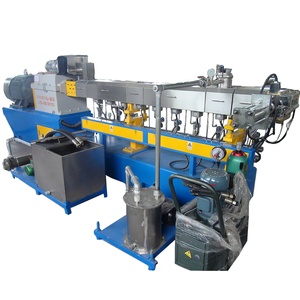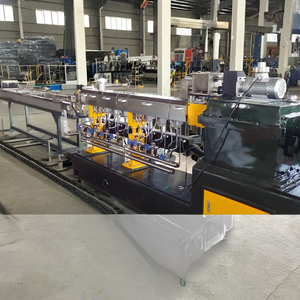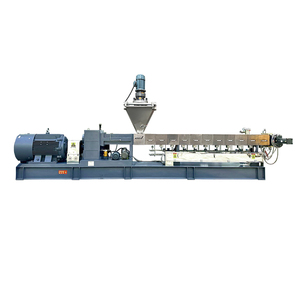
All categories
Featured selections
Trade Assurance
Buyer Central
Help Center
Get the app
Become a supplier

(30720 products available)



























A high-torque co-rotating twin-screw extruder consists of two parallel intermeshing screw elements that are driven by a high-torque motor. The motor provides enough force to turn the screws, pushing and processing the material. The screws work together to increase the force and mix the material efficiently. This type of extruder is designed for effective material processing by providing a strong and thorough motor drive system.
High-torque co-rotating twin-screw extruders are further categorized based on their specific geometrical configurations.
Full Flighted Screws:
Full-flighted screws have a uniform flight all around the screw. It has an unbroken thread that runs the length of the flight. This type of screw is used in high-torque co-rotating twin-screw extruders to convey bulk solid materials. The full flight of the thread pushes bulk solid materials down its length. Because of this, full-flighted screws are also often referred to as conveying screws.
Hollow Flighted Screws:
Hollow-flighted screws have a flight that consists of a thread with a gap in the thread. The gaps in the threads offer openings for fluids to pass through. This feature allows hollow-flighted screws to have a significant mixing effect. Besides, the opening in this type of screw allows for heating or cooling of the material. Thus, hollow-flighted screws are commonly used in twin-screw extruders for processing materials that require both mixing and temperature adjustment.
Elements with nipped lands:
These screw components have narrowed land areas that increase shear forces for mixing materials. They often have a gap for dewatering or venting, which is useful in extrusion operations. Also, the elements can have either a groove or a raised ball, depending on the desired mixing action. Specifically, the raised spheres promote coiling and circular flow within the barrel. Conversely, grooves encourage radial movement from the perimeter to the center. Either method significantly increases the melting and mixing of the materials being extruded.
Coronan elements:
Coronas resemble threads in shape, but the rise of the thread is much less than that of normal threads. Coronam elements create a vast open space when the screws rotate. The open space allows free movement of the material, which results in excellent material melting and mixing.
Intermeshing screws:
Often found in high-torque co-rotating twin-screw extruders, intermeshing screws are screw designs where the two screws are fitted in such a way that they partially penetrate each other. The design allows for better conveying and mixing of materials, improving melt uniformity. Moreover, the close interaction between the screws promotes efficient thermal transfer, which is essential for materials that are sensitive to heat.
The aforementioned are just a few of the many different screw configurations that can be used in high-torque co-rotating twin-screw extruders. Each screw design has its unique features and specific applications. It is also important to note that variations in screw design can affect material processing, including mixing, conveying, and shearing.
The high torque co-rotating twin screw extruder has several applications in different industries.
High torque twin screw extruders can be used in various applications. They can be chosen based on the following parameters.
Production capacity
The main goal when selecting a high-torque extruder is to achieve the desired output. Assess the required production volume and consult with a high-torque screw manufacturer to determine the appropriate size and configuration that can meet capacity without compromising quality.
Material compatibility
High-torque twin-screw extruders are versatile and can process different types of materials, such as polymers, elastomers, thermoplastics, PVC, PET, and wood plastic. Each material has unique characteristics and processing requirements, so it is important to ensure that the selected extruder is compatible with the intended material.
Processes required
High-torque twin-screw extrusion can carry out various processes, including melting, mixing, reaction, polymerization, granulation, and compounding. The screws' design and configuration may vary depending on the specific process. Therefore, it is important to select an extruder capable of handling the required process efficiently and effectively.
Operating environment
High-torque twin-screw extruders can have different degrees of protection against environmental factors. For example, in wet or corrosive environments, extruders with moisture-resistant and anti-corrosion properties should be selected to ensure equipment longevity and reliable operation.
Energy-efficiency
High torque twin screw extrusion requires considerable energy input, especially for high-capacity production. Choosing a high-energy efficient motor can significantly reduce energy consumption and operating costs.
Q: What are high torque twin screw extruders used for?
A: High torque co-rotating twin screw extruders are often connected to a motor that generates more than normal torque, improving the machine’s ability to process high-viscosity materials. They are commonly used in the chemical, food, and plastic industries.
Q: What is the difference between a twin-screw extruder and a single-screw extruder?
A: A single-screw extruder has a single screw that conveys and heats the material through external heaters. The high-torque twin-screw extruder contains two parallel intermeshing screws that rotate together, allowing for better mixing and melting of materials.
Q: Do twin-screw extruders have advantages over single screws?
A: Yes, the high torque twin-screw extruder offers greater flexibility in processing various materials, better melting and mixing efficiency, improved material conveying, and better mechanical properties to the end products.
Q: Can high-torque twin-screw extruders be used for devolatilization?
A: Yes, they can efficiently remove volatiles from the melt while maintaining excellent material conveying and thermal distribution.